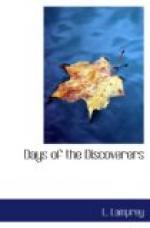It seemed to Nils and Thorolf that some mark or monument should be left to show how far they had really come. A small natural column of dark trap rock was chosen, and while the others fished, or made a seine after the native fashion, Nils marked out an inscription in Runic letters, which are suited to rough work. Not far from the place where they found the stone, and about a day’s journey from camp, was a small high island in a little lake, the kind of place usually chosen by Vikings for a first camp. The stone, set in the middle of this island, would be easily seen by any one looking for it, and savages would not see it at all. When finished it was rafted across to the island and set up, the inscription covering about half of it on both sides. While Nils and several others were thus busy, the remainder of the party were trying the seine. They reached camp after dark to find their booths in ashes, and Nils with his men murdered a little way off, as they had come up from the Rune Stone.[9]
[Illustration: “NILS MARKED OUT AN INSCRIPTION IN RUNIC LETTERS.”—Page 30]
With fury and horror the Norsemen looked upon the destruction. It was all Thorolf and the cooler heads could do to keep the rest from attacking the first Skroelings they saw. But the mischief had been done, without doubt, by the unknown warriors of the plains, who had been perhaps watching their advance. They sadly prepared to return to their boat. But before they went, Thorolf paddled out to the island on two logs, while the others kept guard, and added some lines to the inscription on the stone.
They never saw their Vinland again. Knutson, finding the King fighting hard against the Danes, gave no further thought to the wilderness. Thorolf and a handful of his men finally reached Bergen; Anders stayed in Greenland. More than five centuries afterward, a Scandinavian farmer, grubbing for stumps in a Minnesota marsh, found overgrown by the roots of a tulip tree a stone with an inscription in Runic letters, took it to learned men and had it translated.
“8 Goths and 22 Norsemen upon journey of discovery from Vinland westward. We had camp by two rocks one day’s journey from this stone. We were out fishing one day. When we returned home we found ten men red with blood and dead. AVM save us from evil. have ten men by the sea to look after our ship 14 days journey from this island. Year 1362.”
NOTES
[1] Skal or skoal was the Norwegian word used in drinking a health.
[2] The description of the Norse galley is taken from Du Chaillu’s “Land of the Midnight Sun,” in which the construction of one which was unearthed at Nydam in Jutland is described (Vol. I. 380). The galley “Viking” built in Norway on the model of an actual Viking ship of the early Middle Ages, was taken across the Atlantic in 1893 by a Norwegian crew of fourteen, anchoring in Lake Michigan, after a voyage in which they had no shelter except an awning and cooked their own food as best they could.




